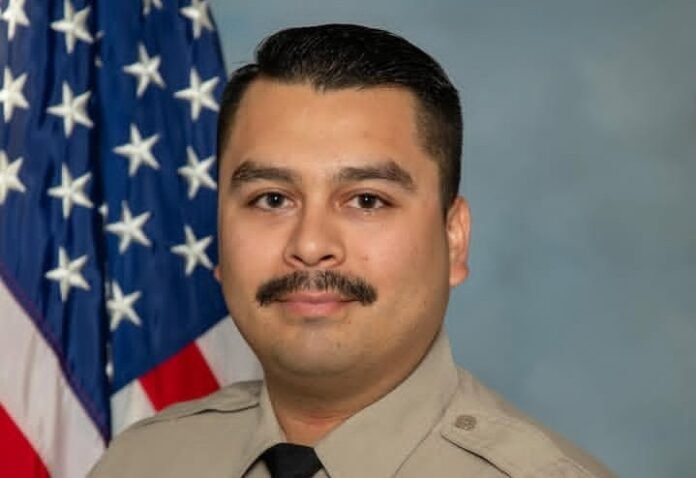Andrew Nuñez
By. Isaac Christopher Lubogo
Abstract
On October 27–28, 2025, a San Bernardino County deputy — identified as Deputy Andrew Nuñez — was fatally shot in Rancho Cucamonga. The suspect fled on a motorcycle at extreme speeds along the 210 Freeway; the pursuit ended when a vehicle driven by an off-duty narcotics officer struck the motorcycle, precipitating a violent crash and the suspect’s apprehension. This article analyzes the incident through legal, procedural, ethical, and comparative lenses. It asks whether the off-duty intervention was a lawful and proportionate exercise of policing power or an instance of vehicular vigilantism, and offers recommendations for policy, training, and oversight to reconcile public safety with civil liberties.
I. Factual Background (load-bearing facts & sources)
On October 27, 2025, responding deputies encountered an armed suspect in Rancho Cucamonga; Deputy Andrew Nuñez was shot and later died of his injuries. The suspect fled on a motorcycle, reaching reported speeds up to approximately 150–170 mph on Interstate 210. The pursuit concluded in Upland/Ontario when the motorcyclist collided with a sedan driven by an off-duty sheriff’s narcotics officer who executed a vehicle “legal intervention,” after which the suspect was taken to hospital and subsequently charged. These events and their sequence are documented in contemporaneous press reports.
II. The Core Legal Questions
1. Justification for Intervention:
Was the off-duty officer’s vehicular strike a lawful use of force under prevailing standards (objective “reasonable officer” test and agency pursuit/use-of-force policies)? Given that the suspect had just killed a deputy and posed an imminent public danger while traveling at extreme freeway speeds, an argument can be made that forcible interdiction was justified to prevent further loss of life. But justification must be measured not only in hindsight (outcome) but against contemporaneous risk assessment and available alternatives.
2. Duty of an Off-Duty Officer:
Do departmental policies treat off-duty officers who elect to intervene as subject to the same constraints and review as on-duty officers? Legally, off-duty officers remain sworn peace officers and may act in exigent circumstances, yet their spontaneous interventions can raise procedural issues (lack of coordination, absence of supervisory direction), which implicates liability and administrative discipline.
3. Causation & Liability:
If a crash injures the suspect or bystanders, was the crash primarily caused by the off-duty intervention or by the suspect’s reckless conduct? Causation analysis matters for potential civil suits and criminal liability; here, reporting suggests the biker was operating at extreme speed and lost control (reportedly removing hands from handlebars), but the strike by the sedan was the proximate precipitant of the crash.
4. Public-Safety vs. Collateral Risk:
High-speed interventions on freeways present grave risks to uninvolved motorists. Even justified force must observe the proportionality principle: does stopping the suspect justify the foreseeable risk to the public introduced by a vehicular takedown?
III. Procedural Analysis
A. Pursuit Policy Compliance
Many agencies restrict high-speed pursuits or prescribe conditions under which they may be continued. Pursuit policies typically require an assessment of the threat posed by the suspect, traffic and environmental conditions, and availability of tactical alternatives (air units, spike strips, roadblocks). The record should be examined to determine whether these alternatives were considered or available before the off-duty intervention.
B. Coordination & Command and Control
An off-duty intervention should be coordinated with command where feasible. The immediacy of this incident — a deputy shot and a suspect fleeing at extreme speed — may have constrained communication, but the absence of coordination can later undermine claims of reasonableness and procedure.
C. Use-of-Force Documentation & Aftercare
Post-incident responsibilities include prompt rendering of medical aid, securing the scene, and documenting actions (body cams, dash cams, radio logs). Any delay or failure to render aid or to preserve evidence raises both legal and ethical concerns.
IV. Ethical and Moral Dimensions
A. Heroism vs. Recklessness
The off-duty officer’s choice to intervene can be framed as courageous and aimed at protecting others. Ethically, stopping a violent felon may prevent further tragedies. Yet virtue ethics demands prudence: a morally laudable act becomes ethically suspect if it recklessly endangers innocents. The ethical calculus must balance the immediate duty to stop a killer with foreseeable harm to the public.
B. Professional Responsibility & Moral Hazard
Officers acting off duty still exercise public power; they must not treat discretion as personal license. There is a moral hazard when individual initiative bypasses institutional safeguards — the very safeguards meant to protect both the public and the officer from catastrophic error.
C. Public Trust and Perception
Transparency matters. An off-duty intervention perceived as vigilante action undermines public confidence. Agencies must demonstrate that rule of law — not serendipity — produced the lawful outcome.
V. Comparative & International Perspectives
A. United States Law & Precedents
U.S. legal standards (Graham v. Connor and subsequent case law) measure force by an objective reasonableness test accounting for the facts known at the time. Jurisprudence allows forcible interdictions when a suspect poses imminent danger, but courts scrutinize whether alternatives existed and whether the officer’s actions were proportionate.
B. Global Standards & Human Rights Considerations
International human-rights norms emphasise necessity and proportionality in law-enforcement use of force. The UN Basic Principles on the Use of Force and Firearms by Law Enforcement Officials require that any use of force be an exceptional measure and that lesser means are preferred. Comparative approaches (e.g., ECHR jurisprudence, African Commission commentary) also stress state obligations to minimize collateral harm in policing interventions.
C. Policy Models to Consider
Several jurisdictions limit vehicle takedowns to trained units, require aviation or spike-strip use, or employ pursuit management centers that authorize continuance. Adopting such models mitigates ad-hoc risk and channels interventions through institutional expertise.
VI. Recommendations (Practical & Doctrinal)
1. Explicit Off-Duty Intervention Protocols:
Agencies should codify when and how off-duty officers may engage in high-risk interdictions — including mandatory notification to dispatch and supervisory oversight where possible.
2. Mandatory Training & Certification for Vehicular Interdiction:
Vehicle takedowns and PIT maneuvers should be restricted to certified officers; off-duty officers should refrain from high-risk physical interdictions without such certification.
3. Prioritise Non-Collision Alternatives:
Invest in air support, rapid deployment spike strip teams, and freeway intelligence (real-time traffic management) to reduce reliance on dangerous vehicle strikes.
4. Pursuit Governance & Risk Assessment Tools:
Use dynamic risk assessment frameworks during chases (weighing suspect’s danger, traffic, environment) and require supervisory authorization for continued pursuit.
5. Transparent After-Action & Civilian Oversight:
Immediate, transparent investigations (internal affairs and independent civilian review) should be mandated, with public reporting to sustain trust.
6. Legal Clarification of Liability & Immunity:
Clarify legal standards for off-duty interventions to reduce ambiguity — including liability exposure and indemnity, subject to compliance with policy and proportionality.
VII. The Lubogo Moral Verdict
Law cannot be measured only by the results it produces; it must be measured by the processes it honors. Stopping a killer is a social good; doing so through a crash that risks innocent lives without due procedure is a legal and moral warning sign. The 210 Freeway incident should be a catalyst for reform: not to punish initiative, but to anchor bravery in discipline, to temper courage with prudence, and to ensure that the state’s use of force is never left to chance or the theatrics of individual daring.
VIII. Conclusion
The Rancho Cucamonga / 210 Freeway episode is a tragic confluence of violence, speed, and split-second decision-making. It forces a difficult but necessary question: when does lawful intervention become an extra-legal taking of risk that the public did not consent to bear? The answer must be resolute: the state — its officers, policies, and courts — must enforce a clear framework that allows decisive action to protect life while minimizing collateral harm and ensuring accountability. Only then does the thin blue line maintain legitimacy; otherwise it becomes a speeding silhouette on an unfettered highway of consequence.
Selected contemporaneous sources consulted
(Used for chronology and load-bearing factual claims)
KABC/ABC7 — “San Bernardino County Deputy Andrew Nunez dies after being shot in Rancho Cucamonga, sparking motorcycle chase.”
Los Angeles Times — “After deputy is killed, fleeing suspect is deliberately knocked off motorcycle in 150 mph chase.”
New York Post — “Motorcycle fugitive wipes out during wild high-speed chase on LA freeway after killing cop.”
ABC7 (chase end) — “Motorcycle chase ends in violent crash on 210 Freeway in Upland.”
News.com.au — coverage summarizing speed and the off-duty officer’s “legal intervention.”








